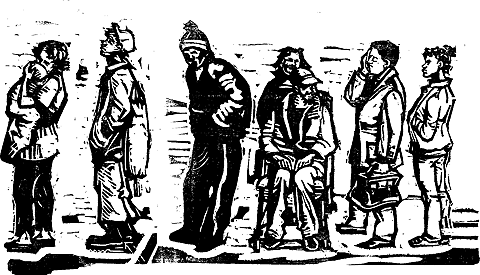 |
||||||||||||
|
November/December 2013
BY DALE SPRUSANSKY Entering its eighteenth year, the Washington, D.C., VA Medical Center’s annual Winterhaven Homeless Stand Down is a well-oiled machine. The event provides homeless and at-risk veterans in the metropolitan area with mental and physical health screenings, food, clothing, housing assistance, and employment opportunities. Last year a record 619 veterans attended the stand down. Given their successful track record, Winterhaven’s organizers could easily be complacent. They resist this temptation. Determined to make the event as accessible and successful as possible, the stand down’s organizers have decided to move the 2014 event from the familiar confines of the VA Medical Center to Freedom Plaza in downtown Washington. The move poses logistical challenges. “This year is going to be the year of challenges, because it’s the unknown,” said Gloria Hairston, director of public affairs at the D.C. VAMC. The biggest challenge will be having to recreate specialized medical center facilities in a public space. “We’ll have to create these external mini medical centers, because each tent for privacy and medical waste purposes has to be its own separate tent,” she said. To the organizers, the extra hassle is well worth the reward. “It gives us an opportunity to touch some unique veterans, some of those who have not been seen or touched before,” Hairston said. Brian A. Hawkins, CEO and director at the D.C. VAMC, echoed Hairston’s sentiment: “The move means we are meeting the veterans in the community.” The change of location also is intended to increase the public’s awareness of the issue of veteran homelessness. “It’s our hope that the community will embrace us and help us, because this is a community issue, not a VA issue,” Hawkins said. “The question is: How do we galvanize the community to really help these folks?” The metropolitan D.C. area is home to 719 homeless veterans, according to Kevin Morton, the VAMC homeless coordinator. Most are Vietnam veterans. Morton believes the stand down plays a critical role in ensuring that VA employees and ordinary citizens do not overlook or underestimate the needs of homeless veterans. “What Winterhaven does is keep the homeless population in the forefront so that they are never forgotten, because it’s a really easy population to forget,” Morton said. “It keeps the veteran humanized and puts a face on the homeless veteran.” Winterhaven is held once a year. “Quite a lot can be done in that eight hours, but there are some things that cannot be done,” Hawkins acknowledged. Still, he believes that the VAMC has solved the dilemma. Last year the VA opened a Community Resource and Referral Center in Northeast D.C. where veterans can receive the services offered at Winterhaven 24 hours a day, 7 days a week, 365 days a year. The building includes a primary care clinic, kitchen, laundry room, showers, food pantry, and a play space for children. Homeless veterans also can go there for referrals to employment services and shelters. The center is intentionally located off the hospital campus. “People who are homeless don’t consider themselves sick a lot of times, and they don’t necessarily want to come to the Medical Center because they see it as a place you come to if you have a physical illness,” Hawkins said. The center’s location is more accessible to the area’s homeless population. “We wanted to capture all those people, to meet them where they were in the community, not in a hospital center,” Hawkins said.
He’s particularly proud that at both the stand down and the new community resource center, family members of homeless veterans are given referrals to local organizations that can help them. Family members, Hawkins said, too often do not qualify for VA assistance and thereby fail to receive the help they often desperately need. “Homelessness does not only affect the veteran, but it affects the entire family,” he stressed. The VA’s partnership with local organizations is reciprocal, as many groups refer veterans to services the VAMC provides. These organizations most likely would be unaware of the VA’s offerings if they hadn’t participated in the stand down, Morton said. “Because they did the stand down, they know what we offer, and they can refer the veteran to the Medical Center.” Corporate and community participation is critical to Winterhaven’s success. “We have over seventy community partners that participate with us in the event,” Morton said. Most of them provide homeless services in D.C. and its Maryland and Virginia suburbs. VA staff members meet with the community partners throughout the year. “We meet with them on a biweekly basis while we’re planning the event,” Morton said. The local partners also help VA staff by promoting the stand down. “They help us advertise in their local shops, whether they be soup kitchens, shelters, or training programs,” Morton noted. To reach those not currently seeking help, the VA goes to the streets to pass out flyers for the event. On the day of the event, the VA provides vans to ensure that the stand down is even more accessible. “We have pickup points at the local shelters and also at the Metro stations,” Morton said. Financial contributions from corporate sponsors and hands-on assistance from local groups allow organizers to execute the stand down at very little cost to the VAMC. “Very few appropriated dollars are spent on this event; it’s mostly driven by donations,” Hairston said. Event planners are always on the lookout for new donors and new community partners. “We plan for Winterhaven all year,” Hairston said. “It’s a donor-driven effort, so when one ends, the next one begins.” Morton applauds the Medical Center staff members who donate their time and expertise to the stand down. “I can’t begin to stress the Medical Center and all it provides during the stand down,” he said. Winterhaven’s organizers often tweak their offerings to reflect the evolving needs of veterans. In recent years this has meant expanding options for women, who now make up 10 percent of stand down attendees. Women have different medical needs than men and are more likely to have young children in tow, making access to safe housing and quality education essential. Veterans from Iraq and Afghanistan have created a generation gap at the stand down. “We’re taking care of older veterans who are in their sixties-plus, and then younger veterans. The services they need are different,” Morton said. While younger veterans usually are looking for jobs and training programs, older veterans are more likely to have health problems. Another complication is that many homeless veterans have other problems: 40 percent of homeless veterans have substance abuse problems, while 30 percent have mental health issues, according to Morton. Hairston believes that the Winterhaven stand down is playing a positive role in helping the VA achieve its goal of eradicating veteran homelessness by 2015. “It shows the very proactive and preventative stance that the Washington, D.C., VA Medical Center is willing to take to achieve the VA’s goal,” she said. Morton believes Winterhaven ultimately will cater to at-risk veterans, not homeless veterans. Nevertheless, he says, there will always be some homeless veterans. “You’re still going to have some homeless people, but it’s going to be less and they’re going to be homeless not as long,” he predicted. “The number of homeless veterans is definitely decreasing.” The next Winterhaven Stand Down will take place January 25. The point of contact for Winterhaven is VAVS Director Stephanie Burns, who can be reached at Stephanie.Burns2@va.gov
|
||||||||||||
|
|
||||||||||||
|
||||||||||||
8719 Colesville Road, Suite 100, Silver Spring. MD 20910 | www.vva.org | contact us |
||||||||||||










